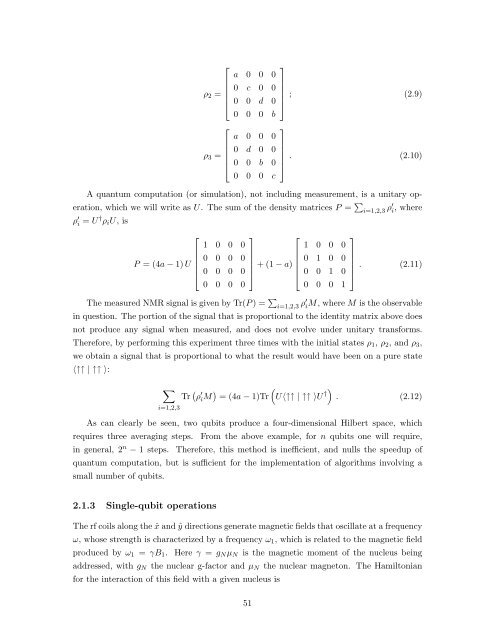Ph.D. Thesis - Physics
Ph.D. Thesis - Physics
Ph.D. Thesis - Physics
Create successful ePaper yourself
Turn your PDF publications into a flip-book with our unique Google optimized e-Paper software.
⎡ ⎤<br />
a 0 0 0<br />
⎢ ⎥<br />
⎢<br />
ρ2 = ⎢<br />
0 c 0 0 ⎥<br />
⎢<br />
⎣ 0 0 d 0<br />
⎥ ; (2.9)<br />
⎦<br />
0 0 0 b<br />
⎡ ⎤<br />
a 0 0 0<br />
⎢ ⎥<br />
⎢<br />
ρ3 = ⎢<br />
0 d 0 0 ⎥<br />
⎢<br />
⎣ 0 0 b 0<br />
⎥ . (2.10)<br />
⎦<br />
0 0 0 c<br />
A quantum computation (or simulation), not including measurement, is a unitary op-<br />
eration, which we will write as U. The sum of the density matrices P = <br />
i=1,2,3 ρ′ i , where<br />
ρ ′ i = U † ρiU, is<br />
⎡ ⎤ ⎡ ⎤<br />
1 0 0 0<br />
1 0 0 0<br />
⎢ ⎥ ⎢ ⎥<br />
⎢<br />
P = (4a − 1) U ⎢<br />
0 0 0 0 ⎥ ⎢<br />
⎥<br />
⎢<br />
⎣ 0 0 0 0<br />
⎥ + (1 − a) ⎢<br />
0 1 0 0 ⎥<br />
⎢<br />
⎦ ⎣ 0 0 1 0<br />
⎥ .<br />
⎦<br />
(2.11)<br />
0 0 0 0<br />
0 0 0 1<br />
The measured NMR signal is given by Tr(P) = <br />
i=1,2,3 ρ′ iM, where M is the observable<br />
in question. The portion of the signal that is proportional to the identity matrix above does<br />
not produce any signal when measured, and does not evolve under unitary transforms.<br />
Therefore, by performing this experiment three times with the initial states ρ1, ρ2, and ρ3,<br />
we obtain a signal that is proportional to what the result would have been on a pure state<br />
〈↑↑ | ↑↑ 〉:<br />
<br />
i=1,2,3<br />
Tr ρ ′ iM <br />
= (4a − 1)Tr U〈↑↑ | ↑↑ 〉U †<br />
. (2.12)<br />
As can clearly be seen, two qubits produce a four-dimensional Hilbert space, which<br />
requires three averaging steps. From the above example, for n qubits one will require,<br />
in general, 2 n − 1 steps. Therefore, this method is inefficient, and nulls the speedup of<br />
quantum computation, but is sufficient for the implementation of algorithms involving a<br />
small number of qubits.<br />
2.1.3 Single-qubit operations<br />
The rf coils along the ˆx and ˆy directions generate magnetic fields that oscillate at a frequency<br />
ω, whose strength is characterized by a frequency ω1, which is related to the magnetic field<br />
produced by ω1 = γB1. Here γ = gNµN is the magnetic moment of the nucleus being<br />
addressed, with gN the nuclear g-factor and µN the nuclear magneton. The Hamiltonian<br />
for the interaction of this field with a given nucleus is<br />
51
















